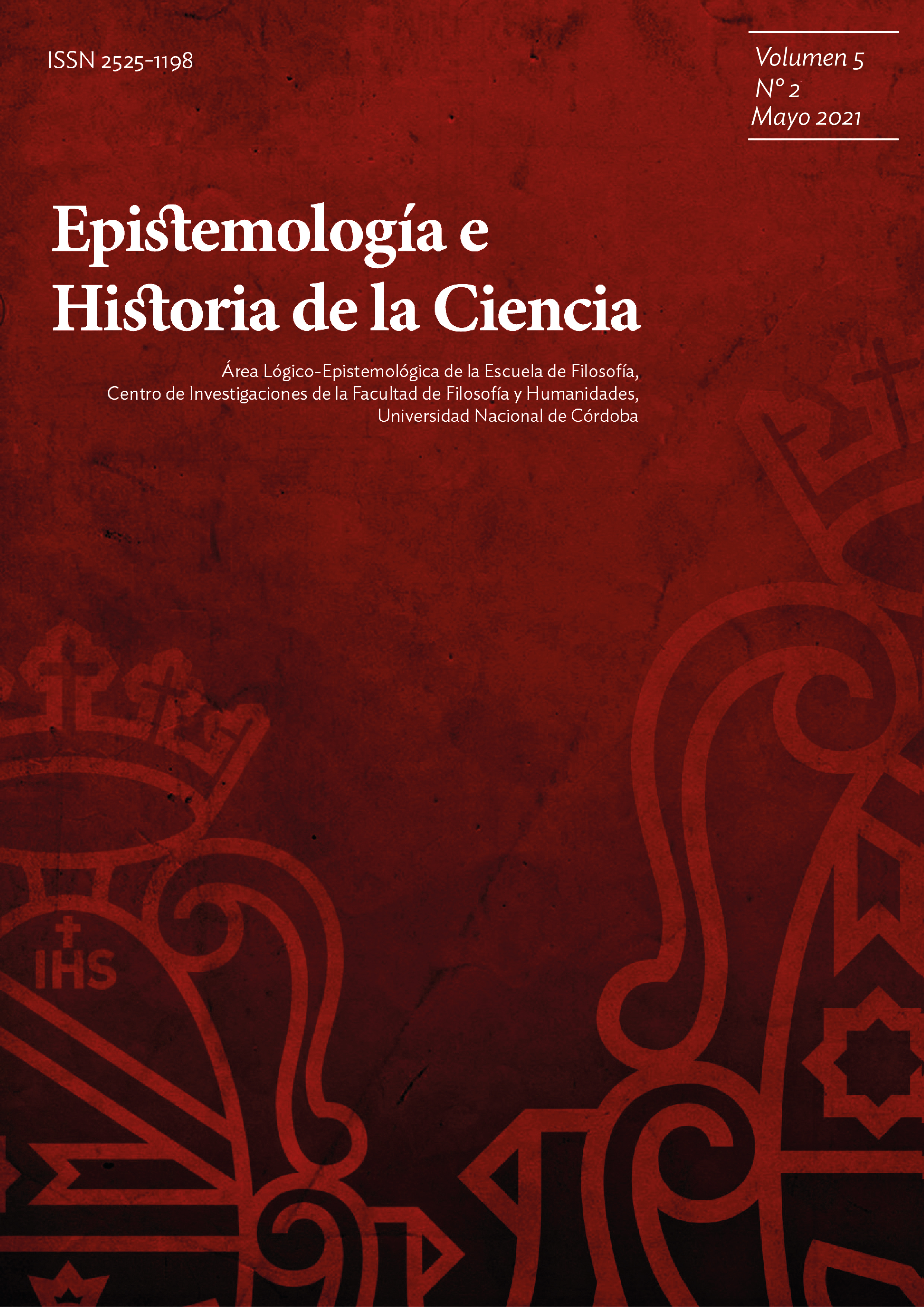Contributions of the A. B. Frank to the teaching of mycorrhiza
Keywords:
mycorrhyzal teaching, historical scientific texts, major ideasAbstract
This paper presents an analysis of historical scientific texts TCH (from Spanish Textos Científicos Históricos) by Albert B. Frank on mycorrhiza. The analysis allowed the identification of three major ideas from the study of mycorrhiza while allowing the identification of conceptual aspects and explanatory resources. For the research, a qualitative methodology of a descriptive-interpretive type was used, consisting of four stages, which were: select, constitute, analyze, and propose. It is concluded that the realization of historical studies facilitates the identification and recovery of ideas, concepts, and explanatory resources immersed in the TCH, which tend to go unnoticed in current curricula and that can acquire great value in the teaching and learning processes of the sciences of mycorrhiza.
Downloads
References
Andrade-Torres A. (2010). Micorrizas: antigua interacción entre plantas y hongos Ciencia 61, 84-86.
Béjar, M. D. (2015). Historia del mundo contemporáneo (1870-2008). Editorial de la Universidad de La Plata.
Brown, D. E., & Clement, J. (1989). Overcoming misconceptions via analogical reasoning: Abstract transfer versus explanatory model construction. Instructional science, 18(4), 237-261.
Cabrera, H. G., & Villa, M. D. (2018). Diseño de unidades didácticas a partir de estudios de caso histórico científicos. En H. G. Cabrera (Ed.), Educación en biología: Aportes de estudios históricos al diseño de unidades didácticas (1.ª ed., pp. 15-30). Universidad del Valle.
Camargo-Ricalde, S. L., Montaño, N. M., De la Rosa Mera, C. J., & Montaño Arias, S. A. (2012). Micorrizas: una gran unión debajo del suelo. Revista Digital Universitaria, 13(7), 19. http://www.revista.unam.mx/vol.13/num7/art72/art72.pdf
Cerda, H. (1991). Los elementos de la investigación. Bogotá: El Búho.
Chang, H. (2016). Who cares about the history of science? Notes Rec, 1-17.
Cherif, A. H. (1990). Mutualism the forgotten concept in teaching science. The American Biology Teacher, 52(4), 206-208. https://doi.org/10.2307/4449085
Curtis, H., & Schnek, A. (2008). Biología. Ed. Médica Panamericana.
Flick, U. (2007). Introducción a la investigación cualitativa (2ª ed.). Madrid: Morata.
Frank, A. B. (1885). Ueber die auf Wurzelsymbiose beruhende Ernährung gewisser Bäume durch unterirdische Pilze. Berichte der Deutschen Botanischen Gesellschaft, 3, 128-145.
Frank, A. B. (1887). Ueber neue Mykorrhiza-Formen. Berichte der Deutschen Botanischen Gesellschaft,5, 395-409.
Frank, A. B. (1888). Ueber die physiologische Bedeutung der Mykorhiza. Berichte der Deutschen Botanischen Gesellschaft, 6, 248-269.
González González, B. M., & Moreno Jiménez, T. (1998). Las analogías en la enseñanza de las ciencias. Actas II Simposio sobre la docencia de las ciencias experimentales en la enseñanza secundaria (pp.204-206). Madrid: Ediciones de la Torre.
Harlen, W. (Ed.). (2012). Principios y grandes ideas para la educación en ciencias. Santiago de Chile: Academia Chilena de Ciencias.
Hernández, R., Fernández, C., y Baptista, P. (2006). Metodología de la Investigación. México: McGraw-Hill.
Izquierdo, M., García-Martínez, A., Quintanilla, M., & Adúriz-Bravo, A. (2016). Historia, filosofía y didáctica de las ciencias: Aportes para la formación del profesorado de ciencias (1ra ed.). Bogota: Universidad Distrital Francisco José de Caldas.
Koide, R. T., & Mosse, B. (2004). A history of research on arbuscular mycorrhiza. Mycorrhiza, 14(3), 145-163. https://doi.org/10.1007/s00572-004-0307-4
Ministerio de Educación Nacional, República de Colombia. (2004). Estándares básicos de competencias en ciencias naturales y ciencias sociales. Bogotá: Cargraphics S. A.
Perales, F. J., & Jiménez, J. de D. (2002). Las ilustraciones en la enseñanza-aprendizaje. Enseñanza de las Ciencias, 20(3), 369-386.
Philips, J. M. y Hayman, D. S. (1970). Improved procedures for clearing roots and staining parasitic and vesicular-arbuscular mycorrhizal fungi for rapid assessment of infection. Transactions of the British mycological Society, 55,158-161.
Ryan, F. (2015). Darwin’s blind spot: The role of living interactions in evolution. Swift Publishers.
Solsona, N. (2015). Análisis de las estrategias de autorización de mujeres científicas en la Ilustración. Revista Física Y Cultura, (9), 25-40.
Suárez, M. C. (2006). Propuesta de enseñanza-aprendizaje sobre las interacciones entre las poblaciones y su vocabulario científico. Universidad de Antioquia.
Trappe, J. M. & Fogel, R. D. (1977). Ecosystematic functions of mycorrhizae. En The belowground ecosystem: a synthesis of plant-associated processes (vol. 26, pp. 205-214). Recuperado de http://andrewsforest.oregonstate.edu/pubs/pdf/pub2044.pdf
Trappe, J. M. (2005). A. B. Frank and mycorrhizae: The challenge to evolutionary and ecologic theory. Mycorrhiza, 15(4), 277-281. https://doi.org/10.1007/s00572-004-0330-5
Universidad Nacional del Litoral. (2016). Generalidades de las micorrizas. Practica de laboratorio H y L # 12 Micorrizas. Departamento de Biología. Argentina. Recuperado de:https://www.studocu.com/es-ar/document/universidad-nacional-del-litoral/biologia/trabajos-practicos/practica-12-micorrizas-hy-l/2985808/view
Zapata Villamil, C. S. (2014). Enseñanza-Aprendizaje del concepto de bacteria en estudiantes de segundo de primaria de zona rural. Universidad Nacional de Colombia.
Downloads
Published
How to Cite
Issue
Section
License
Copyright (c) 2021 Epistemología e Historia de la Ciencia

This work is licensed under a Creative Commons Attribution-NonCommercial-NoDerivatives 4.0 International License.
En todos los lugares donde aplique, esta obra está bajo una licencia Creative Commons Reconocimiento-NoComercial-SinObrasDerivadas 4.0 .
- Los autores/as conservarán sus derechos de autor y garantizarán a la revista el derecho de primera publicación de su obra, el cual estará simultáneamente sujeto a la Licencia de reconocimiento de Creative Commons que permite a terceros compartir la obra, siempre que se indique su autor y su primera publicación en esta revista.
- Los autores/as podrán adoptar otros acuerdos de licencia no exclusiva de distribución de la versión de la obra publicada (p. ej.: depositarla en un archivo digital institucional o publicarla en un volumen monográfico), siempre que se indique la publicación inicial en esta revista.
- Se permite y recomienda a los autores/as difundir su obra a través de Internet (p. ej.: en archivos digitales institucionales o en su página web) antes y durante el proceso de envío.
- Las licencias de las imágenes de terceros incluidas en los artículos pueden estar sujetas a otros términos; los autores/as son responsables de asegurar la veracidad de su origen, la información de la fuente original provista y su permiso de reproducción en esta publicación, que puede ser exclusivo.














